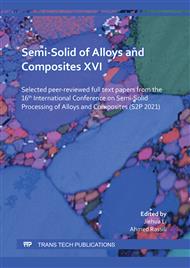p.82
p.98
p.105
p.111
p.119
p.127
p.133
p.140
p.149
Visco-Elastic Properties of Semi-Solid Alloys
Abstract:
Oscillation and creep experiments have been performed with Semi-Solid Material (SSM) AlSi7 with 35% solid fraction to investigate the early visco-elastic properties after shearing of the material in a Searle Rheometer. The preparation of the SSM has been done in situ using a standard procedure to guarantee for all experiments the same initial properties of the material. First, oscillation experiments at low amplitude allowed to study the evolution of material structure with time. Subsequently, creep experiments have been performed changing the resting period based on previous results. Creep experiments are characterized by exposing the material to a sudden increase of shear stress. The resolution in time has been 0.01 seconds, which allows observing the dynamics of the development of visco-elastic properties.The material exhibits viscoelastic properties that are becoming more pronounced with longer resting time. This is in accordance with previous experiments where the ratio between elastic and viscous properties increases with increasing resting time. The development of the elastic properties follows the increase of the yield stress due to the creation of an internal structure of the material, which starts immediately after stopping shearing. The investigation of the short-term response of SSM can be particularly relevant for industrial practice, where material deformation during die filling is very fast and the material flow does not take place in steady-state condition.
Info:
Periodical:
Pages:
119-126
Citation:
Online since:
January 2022
Authors:
Keywords:
Price:
Сopyright:
© 2022 Trans Tech Publications Ltd. All Rights Reserved
Share:
Citation:


